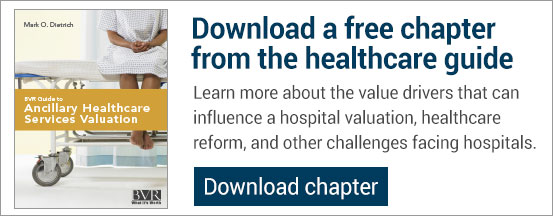Key challenges facing hospitals and what you need to know before valuing them
Hospital valuations require a thorough understanding of the industry and, specifically, the challenges and opportunities related to the Affordable Care Act (ACA) and overall transformation within the healthcare industry. In BVR’s publication, Guide to Ancillary Healthcare Services Valuation, contributors G. Don Barbo and Robert M. Mundy cover some of the top challenges hospitals face and how these challenges have changed the way hospitals conduct business.
Transition to Value-Based Reimbursement
No other issue presents as many challenges to the U.S. healthcare system as the shift to value-based reimbursement; however, every challenge presents an opportunity for success. Traditionally, hospitals (and most other health service providers) have been paid under a fee-for-service model in which payment was made for procedures performed regardless of the efficacy of the procedure or the quality of patient care. However, the trend of paying for quality care was kicked into high gear with the passage of the ACA. Many commercial insurers are following the government’s lead and have begun to reimburse hospitals for the quality of care provided.
This transformation in reimbursement is generating changes in the way healthcare services are provided. Hospitals are affiliating with other health service providers in various initiatives to better coordinate patient care, reduce costs, and provide more efficient healthcare services. Some of these initiatives include accountable care organizations, clinical co-management arrangements, clinically integrated networks, patient-centered medical homes, and retail health clinics. Gone are the days when a hospital only concerned itself with caring for the patients within its four walls. In this new era of healthcare, successful hospitals will proactively seek out partnerships and affiliations with other service providers in the community to provide higher quality and better coordinated patient care.
Increased Reporting Requirements
The shift to value-based reimbursement brings about increased administrative and reporting requirements for hospitals. Hospitals now must monitor and record patient outcomes and quality metrics in order to appropriately report the results to third-party payers. To appropriately address these new reporting requirements, hospitals need to train and educate physicians and providers to document the quality data in a manner that can be efficiently reported to outside parties.
Another administrative burden to hospitals is the conversion from ICD-9 to ICD-10. International Classification of Diseases (ICD) is the coding system used to submit patient claims to payers. ICD-10 is a total redesign of the diagnosis codes of ICD-9, requiring hospitals to make significant capital investments in information technology.
Increased Governmental Scrutiny
Hospitals are facing unprecedented governmental scrutiny and regulatory enforcement actions. The Centers for Medicare & Medicaid Services (CMS) created the Health Care Fraud Prevention and Enforcement Action Team (HEAT) in 2009 to prevent and prosecute fraud and abuse in the Medicare and Medicaid programs. Additionally, the Medicare Recovery Audit Contractor (RAC) program was instituted in 2006 to identify Medicare overpayments and underpayments to healthcare providers. The ACA increased the funding levels for these and other fraud prevention programs and expanded the reach of the RAC program. As a result, the Health Care Fraud and Abuse Control (HCFAC) program reported that the government recovered over $2.3 billion in healthcare fraud judgments and settlements in 2014.
Several whistleblower cases also have been successfully brought against hospitals that were alleged to be in violation of the Stark Law. The penalties imposed were severe, reaching into the multimillion-dollar range and beyond. In several such instances, these hospitals had relied upon a third-party fair market value opinion. It is therefore imperative for healthcare appraisers to understand the potential risks associated with such transactions.
Physician Shortages
A growing problem facing hospitals is a shortage of medical service providers. According to an April 2019 study conducted by IHS Inc. at the request of The Association of American Medical Colleges (AAMC), demand for physician services will outpace the supply of physicians, leading to a projected shortfall of approximately 46,900 to 121,900 physicians by 2032. The majority of the projected shortfall is anticipated for specialty surgeons. Rural hospitals will most likely feel the brunt of these shortages, as many already experience difficulty in attracting physician specialists.
Conclusion
While we’ve covered some of the key challenges hospitals face, the more an appraiser can develop an understanding of the hospital industry, the more sound opinion of value he or she can render. All hospitals and the communities in which they operate have unique characteristics that must be examined and properly considered.
To expand your knowledge before performing one of these complex engagements, download a free chapter from the Guide to Ancillary Healthcare Services Valuation that covers not only the challenges hospitals face, but also the top value drivers, healthcare reform, the valuation process, and more.

